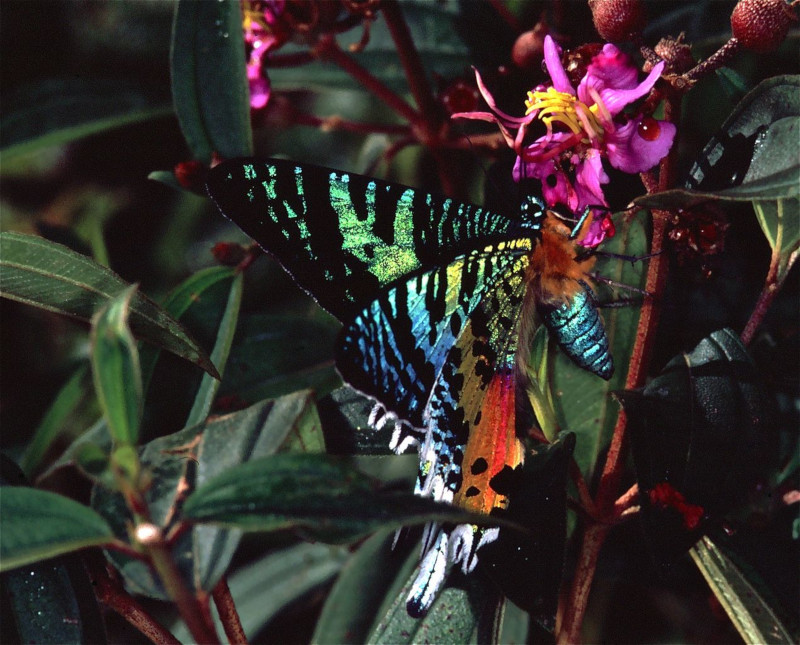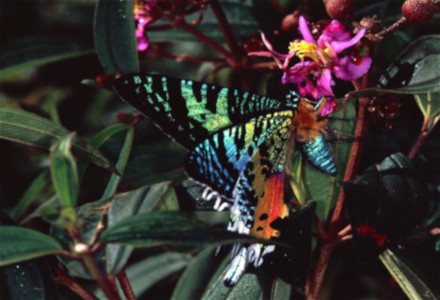
Photographer: Bernard DUPONT
CC License: https://bit.ly/3beZVD4
Sunset Moth Facts
- This living kaleidoscope most commonly goes by the simple but appropriate name of the Sunset Moth. The truly stunning insect also goes by another common term, though. That alternate name’s that of the similar Madagascan Sunset Moth.
- The scientific name for this wonder of Nature, however, remains decidedly far more difficult to pronounce. That’s because scientists and researchers know the species best by the highly tongue-twisting name of the Chrysiridia rhipheus.
- Regardless of the name one uses to refer to it, though, it easily stands out from its peers. In point of fact, many individuals consider it the most beautiful insect of its kind on earth. And that’s out of the roughly 174,300 known Lepidoptera in the world.
- The British naturalist and entomologist Dru Drury made the first formal recognition of it as a separate species. This scientifically noteworthy event took place in the year 1773. Since that time, however, it’s born many different names.
- Although it has a limited habitat, the Sunset Moth appears to have a sufficient and stable population. This further seems to be true across the majority of its native range. The IUCN, therefore, currently has no listing for the invertebrate on its Red List.
- It nevertheless does face certain threats. Among these is the fact that it’s only protected in part of its range. Due to this, habitat loss certainly poses a danger. The greatest threat to its existence, however, likely comes in the form of climate change.
Related Articles
Cecropia Moth White Ermine Calleta silkmoth
Photographer: Frank Vassen
CC License: https://bit.ly/2ZoPjMF
Sunset Moth Physical Description
While the beauty of the Sunset Moth obviously ranks as its most impressive feature, it’s not the only one. That’s because, in addition to that, the arthropod also ranks as a moderately large member of its Order. Beauty and size make for a remarkable combination.
Unlike many of its kindred, though, this arthropod does not display any noticeable degree of sexual dimorphism. This further holds true in regards to both size and appearance. This characteristic also distinguishes it from the majority, but not all, of its relatives.
Mature adults of both genders attain an average wingspan measuring 2.8 – 3.5 in (7 – 9 cm). Exceptional specimens, however, sometimes reach significantly larger sizes. In fact, some of these individuals have wingspans measuring as much as 4.3 in (11 cm).
Its visual splendor nevertheless does qualify as its most recognizable characteristic. It’s known the magnificent, and highly varied, brilliant coloring of its wings. Yet another surprise awaits here, though. This, in point of fact, is actually an illusion.
Nature actually blessed the wings of the Sunset Moth with an extraordinary feature. Its wings have a natural covering of thousands of clear scales which scatter light, like a prism. As a result, the colors and patterns change in a continuously mind-boggling manner.
- Kingdom: Animalia
- Phylum: Arthropoda
- Class: Insecta
- Order: Lepidoptera
- Family: Uraniidae
- Genus: Chrysiridia
- Species: C. rhipheus
Photographer: Frank Vassen
CC License: https://bit.ly/3pqPhOW
Sunset Moth Distribution, Habitat, and Ecology
Most unfortunately, the glorious Sunset Moth only inhabits a tiny portion of the globe. More specifically, the marvel of evolution appears to only live on the island of Madagascar. This, therefore, places native its location about 250 mi (400 km) of the east coast of Africa.
Within this range, though, the dazzling Lepidoptera appears in almost every part of the island. The lone exceptions to this consist of the extreme southern sections and the southwest portions. In this manner, it also demonstrates its extreme adaptability.
That’s because the regions this astounding natural beauty does inhabit include widely varied habitats. These include areas of rainforest and dry deciduous forests, along with others. Essentially, it depends on the presence of at least one of four various host plants.
Its larval form feeds voraciously on these, after emerging. In fact, it’s one of the most destructive of all known caterpillars. That’s because, in general, the emerging larva defoliate and destroy virtually all parts of the host plant. These even eat the fruit and flowers.
Nature did not simply stop with its beauty and size, when it came to creating a marvel. That’s due to the fact that this arthropod differs from most moths in yet another manner. Unlike them, this species flies by day. usually in clearings and over the local canopy.
In the light of the day, the bright colors displayed by the Sunset Moth serve a purpose. These warn potential predators that it’s actually toxic, due to alkaloids in the plants it consumes. The beauty therefore has very few natural predators, unlike most of its kind.
Species Sharing Its Range
Check out our other articles on 6 Geological Wonders of India, Elegance Coral, Saint Mary’s Islands, Swamp Wallaby, Black-and-white hawk-eagle, Satanic Leaf-Tailed Gecko

